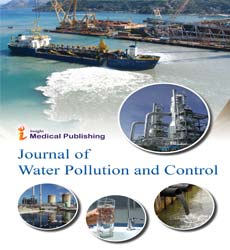Plant Nutrient and Biological Water Quality of Legedadi Reservoir (Ethiopia) Spatiotemporal Variations
Andriya Steven*
Managing editor, Journal of Water Pollution and Control, London, UK
- *Corresponding Author:
- Andriya Steven
Managing editor
Journal of Water Pollution and Control
London, UK
E-mail: waterpollut@imedresearch.com
Received Date: May 01, 2021; Accepted Date: May 14, 2021; Published Date: May 21, 2021
Citation: Steven A (2021) Plant Nutrient and Biological Water Quality of Legedadi Reservoir (Ethiopia): Spatiotemporal Variations. J Water Pollut Control. Vol. 3 No. 3:13.
Abstract
All of the limiting nutrients showed substantial temporal and spatial variation (p=0.05), with the majority of peak levels occurring during short and long rains. Despite the absence of green patches or algal scums on the surface of the reservoir, phytoplankton biomass was found to be extremely high and to vary significantly seasonally (p=0.05). Throughout the study period, blue green algae, particularly Microcystis and Anabaena, dominated the community (63%-95%), especially during the dry and brief wet months. The algal bloom was triggered by considerable temporal variations in transparency and high quantities of nutrients, according to this study. The year-round persistent turbidity, relatively high temperature, and low under-water irradiance promoted blue green algae, especially Microcystis and Anabaena species, which appear to be linked to the current algal bloom.
Introduction
Fresh water bodies, such as reservoirs, are finite resources that are necessary for agriculture, industry, and human survival. It is impossible to achieve sustainable socioeconomic growth in a country without readily available water in sufficient quantity and of acceptable quality. Agriculture, industries, and urban populations near to or in the reservoir drainage basin can exacerbate the deterioration of reservoir water quality and human health problems by releasing toxins through waste water discharge into these water bodies or their source water.
To fully comprehend the dynamics of intermittent algal blooms and the underlying environmental variables, researchers must examine changes in the species composition and relative abundance of phytoplankton resident in the reservoir over time in relation to some physicochemical parameters.
The reservoir under inquiry was Legedadi, which is about 30 kilometres northeast of Ethiopia's capital, Addis Ababa. It has a highly uneven form. The reservoir is located between 9˚20'N and 38˚45'E, at an elevation of 2450 metres above sea level, and is paved near the main route to the country's north-eastern region. The reservoir was built with a maximum depth of 34 metres near the dam and a minimum depth of 4 metres around the perimeter.
Nitrate (NO3-N), ammonium (NH4 ± N), soluble reactive phosphate (pO43), and soluble reactive silica (SiO2) were all tested.
Phytoplankton biomass was calculated by spectrophotometric analysis of 90% acetone extracts of particulate material that remained after filtration via Whatman glass fibre filters (GF/C).
Seasonal and regional variations in Soluble Reactive Phosphate (SRP) were significant, with greatest levels obtained during the short and long wet months of the year. Because the reservoir is unfenced, grazer animals have direct access to the water, and their waste from barnyard pastures, feedlots, and rangelands is washed away during runoff and dumped directly into the reservoir water. Furthermore, the majority of the major feeder streams upstream are utilised for watering animals, washing clothes, and other uses, contributing to the overall high concentrations of SRP.
Conclusion
Plant nutrients and phytoplankton biomass were found to be high throughout the year in the Legedadi reservoir, and they varied both seasonally and geographically. Year-round high turbidity favoured the most bothersome cyanobacteria (Microcystis and Anabaena) to predominate throughout the year. Throughout the year, the reservoir's levels of growth-limiting plant nutrients (ammonium, nitrate, soluble reactive phosphate, and silica) were high enough to trigger algal blooms. The seasonal unpredictability of these conditions, in addition to the elevated levels of turbidity and nutrients, provided an additional element that favoured cyanobacterial blooms in the reservoir.
Open Access Journals
- Aquaculture & Veterinary Science
- Chemistry & Chemical Sciences
- Clinical Sciences
- Engineering
- General Science
- Genetics & Molecular Biology
- Health Care & Nursing
- Immunology & Microbiology
- Materials Science
- Mathematics & Physics
- Medical Sciences
- Neurology & Psychiatry
- Oncology & Cancer Science
- Pharmaceutical Sciences
